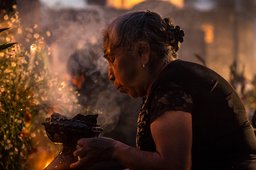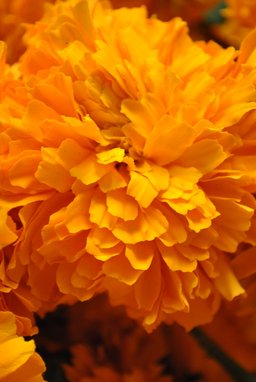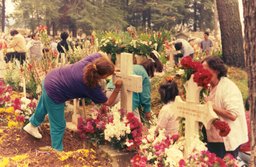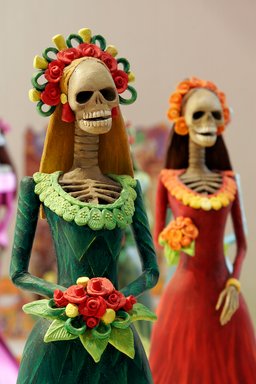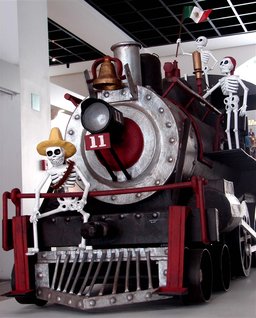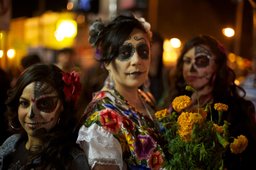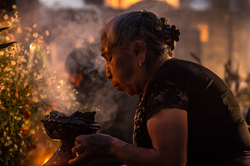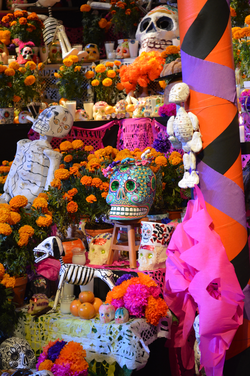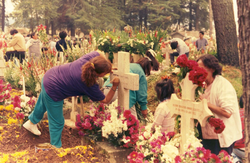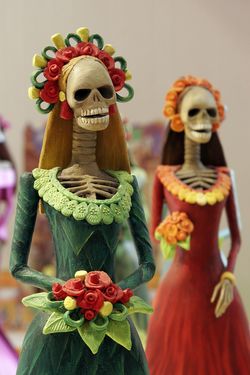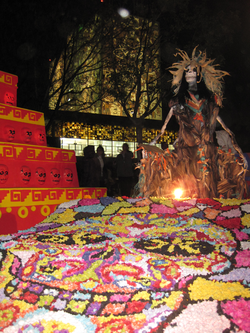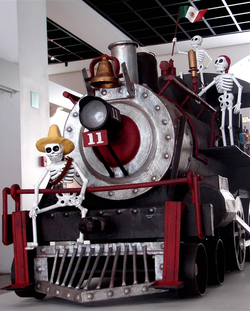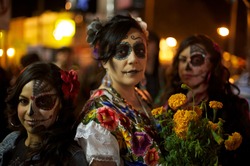Day of the Dead
Day of the Dead
| Day of the Dead | |
|---|---|
| Observed by | Mexicoand regions with largeHispanicpopulations |
| Type | CulturalSyncretic Christian |
| Significance | Prayer and remembrance of friends and family members who have died |
| Celebrations | Creation of altars to remember the dead, traditional dishes for Day of the Dead |
| Begins | October 31 |
| Ends | November 2 |
| Date | October 31 |
| Next time | 31 October 2018(2018-10-31) |
| Frequency | Annual |
| Related to | All Saints' Day |
The** Day of the Dead** ( Spanish: Día
de Muertos) is a Mexican holiday celebrated throughout Mexico, in particular the Central and South regions, and by people of Mexican ancestry living in other places, especially the United States. It
is acknowledged internationally in many other cultures. The
multi-day holiday focuses on gatherings of family and friends to pray for and remember friends and family members who have died, and help support their spiritual journey. In
2008, the tradition was inscribed in the Representative List of the Intangible Cultural Heritage of Humanity by UNESCO. [46]
The holiday is sometimes called Día de los Muertos [47] [48] in Anglophone countries, a back-translation of its original name, Día de Muertos.
It is particularly celebrated in Mexico where the day is a public holiday.
Prior to Spanish colonization in the 16th century, the celebration took place at the beginning of summer.
Gradually, it was associated with October 31, November 1, and November 2 to coincide with the Western Christianity triduum of Allhallowtide: All Saints' Eve, All Saints' Day, and All Souls' Day.
[3] Traditions connected with the holiday include building private altars calledofrendas, honoring the deceased using calaveras, aztec marigolds, and the favorite foods and beverages of the departed, and visiting graves with these as gifts.
[6] Visitors also leave possessions of the deceased at the graves.
Scholars trace the origins of the modern Mexican holiday to indigenous observances dating back hundreds of years and to an Aztec festival dedicated to the goddess Mictecacihuatl.
The holiday has spread throughout the world, being absorbed into other deep traditions in honor of the dead.
It has become a national symbol and as such is taught (for educational purposes) in the nation's schools.
Many families celebrate a traditional " All Saints' Day" associated with the Catholic Church.
Originally, the Day of the Dead as such was not celebrated in northern Mexico, where it was unknown until the 20th century because its indigenous people had different traditions.
The people and the church rejected it as a day related to syncretizing pagan elements with Catholic Christianity.
They held the traditional 'All Saints' Day' in the same way as other Christians in the world.
There was limited Mesoamerican influence in this region, and relatively few indigenous inhabitants from the regions of Southern Mexico, where the holiday was celebrated.
In the early 21st century in northern Mexico, Día de Muertos is observed because the Mexican government made it a national holiday based on educational policies from the 1960s; it has introduced this holiday as a unifying national tradition based on indigenous traditions.
The Mexican Day of the Dead celebration is similar to other societies' observances of a time to honor the dead.
The Spanish tradition, for instance, includes festivals and parades, as well as gatherings of families at cemeteries to pray for their deceased loved ones at the end of the day.
| Day of the Dead | |
|---|---|
| Observed by | Mexicoand regions with largeHispanicpopulations |
| Type | CulturalSyncretic Christian |
| Significance | Prayer and remembrance of friends and family members who have died |
| Celebrations | Creation of altars to remember the dead, traditional dishes for Day of the Dead |
| Begins | October 31 |
| Ends | November 2 |
| Date | October 31 |
| Next time | 31 October 2018(2018-10-31) |
| Frequency | Annual |
| Related to | All Saints' Day |
Observance in Mexico
Origins
The Day of the Dead celebrations in Mexico developed from ancient traditions among its pre-Columbian cultures.
Rituals celebrating the deaths of ancestors had been observed by these civilizations perhaps for as long as 2,500–3,000 years.
[51] The festival that developed into the modern Day of the Dead fell in the ninth month of the Aztec calendar, about the beginning of August, and was celebrated for an entire month.
The festivities were dedicated to the goddess known as the "Lady of the Dead", corresponding to the modern La Calavera Catrina.
By the late 20th century in most regions of Mexico, practices had developed to honor dead children and infants on November 1, and to honor deceased adults on November 2.
November 1 is generally referred to asDía de los Inocentes ("Day of the Innocents") but also asDía de los Angelitos ("Day of the Little Angels"); November 2 is referred to asDía de los Muertos orDía de los Difuntos ("Day of the Dead").
Beliefs

Families tidying and decorating graves at a cemetery in Almoloya del Río in the State of Mexico, 1995
Frances Ann Day summarizes the three-day celebration, the Day of the Dead:
| “ | On October 31, All Hallows Eve, the children make a children's altar to invite theangelitos(spirits of dead children) to come back for a visit.November 1 is All Saints Day, and the adult spirits will come to visit.November 2 is All Souls Day, when families go to the cemetery to decorate the graves and tombs of their relatives.The three-day fiesta is filled with marigolds, the flowers of the dead;muertos(the bread of the dead); sugar skulls; cardboard skeletons; tissue paper decorations; fruit and nuts; incense, and other traditional foods and decorations. | ” |
| —Latina and Latino Voices in Literature | ||
People go to cemeteries to be with the souls of the departed and build private altars containing the favorite foods and beverages, as well as photos and memorabilia, of the departed.
The intent is to encourage visits by the souls, so the souls will hear the prayers and the comments of the living directed to them.
Celebrations can take a humorous tone, as celebrants remember funny events and anecdotes about the departed.
Plans for the day are made throughout the year, including gathering the goods to be offered to the dead.
During the three-day period families usually clean and decorate graves; most visit the cemeteries where their loved ones are buried and decorate their graves withofrendasTagetes erectaNāhuatl In modern Mexico the marigold is sometimes calledsouls of the dead to the offerings.
Toys are brought for dead children (los angelitos, or "the little angels"), and bottles of orpulqueatole.
Some families haveofrendas in homes, usually with foods such as candied pumpkin,pan de muerto food after the festivities, they believe it lacks nutritional value.
Pillows and blankets are left out so the deceased can rest after their long journey.
In some parts of Mexico, such as the towns of Mixquic, Pátzcuaro and Janitzio, people spend all night beside the graves of their relatives.
In many places, people have picnics at the grave site, as well.
Some families build altars or small shrines in their homes; these sometimes feature a Christian cross, statues or pictures of the Blessed Virgin Mary, pictures of deceased relatives and other people, scores of candles, and anofrenda.
Traditionally, families spend some time around the altar, praying and telling anecdotes about the deceased.
In some locations, celebrants wear shells on their clothing, so when they dance, the noise will wake up the dead; some will also dress up as the deceased.
Public schools at all levels build altars withofrendas, usually omitting the religious symbols.
Government offices usually have at least a small altar, as this holiday is seen as important to the Mexican heritage.
Those with a distinctive talent for writing sometimes create short poems, calledcalaveras (skulls), mocking epitaphs of friends, describing interesting habits and attitudes or funny anecdotes.
This custom originated in the 18th or 19th century after a newspaper published a poem narrating a dream of a cemetery in the future, "and all of us were dead", proceeding to read the tombstones.
Newspapers dedicatecalaveras to public figures, with cartoons of skeletons in the style of the famouscalaverasDon Juan TenorioJosé Zorrilla (1817–1893) are also traditional on this day.
José Guadalupe Posada created a famous print of a figure he calledLa Calavera Catrina
A common symbol of the holiday is the skull (in Spanishcalaveracalacas name of the recipient on the forehead.
Sugar skulls can be given as gifts to both the living and the dead.
Other holiday foods includepan de muerto, a sweet egg bread made in various shapes from plain rounds to skulls and rabbits, often decorated with white frosting to look like twisted bones.
The traditions and activities that take place in celebration of the Day of the Dead are not universal, often varying from town to town.
For example, in the town of Pátzcuaro on the Lago de Pátzcuaro in Michoacán, the tradition is very different if the deceased is a child rather than an adult.
On November 1 of the year after a child's death, the godparents set a table in the parents' home with sweets, fruits,* pan de muerto*, a cross, a rosary (used to ask the Virgin Mary to pray for them) and candles.
This is meant to celebrate the child's life, in respect and appreciation for the parents.
There is also dancing with colorful costumes, often with skull-shaped masks and devil masks in the plaza or garden of the town.
At midnight on November 2, the people light candles and ride winged boats calledmariposas (butterflies) to Janitzio, an island in the middle of the lake where there is a cemetery, to honor and celebrate the lives of the dead there.
In contrast, the town of Ocotepec, north of Cuernavaca in the State of Morelos, opens its doors to visitors in exchange forveladoras (small wax candles) to show respect for the recently deceased.
In return the visitors receive tamales andatole.
This is done only by the owners of the house where someone in the household has died in the previous year.
Many people of the surrounding areas arrive early to eat for free and enjoy the elaborate altars set up to receive the visitors.
In some parts of the country (especially the cities, where in recent years other customs have been displaced) children in costumes roam the streets, knocking on people's doors for acalaverita, a small gift of candies or money; they also ask passersby for it.
This relatively recent custom is similar to that of Halloween's trick-or-treating in the United States.
Some people believe possessing Day of the Dead items can bring good luck.
Many people get tattoos or have dolls of the dead to carry with them.
They also clean their houses and prepare the favorite dishes of their deceased loved ones to place upon their altar orofrenda.
Food
Pan de muerto nd calaveras are associated specifically with Day of the Dead.
Pan de muerto is a type of sweet roll shaped like a bun, topped with sugar, and often decorated with bone-shaped phalanges pieces.
[17] Calaveras, or sugar skulls, display colorful designs to represent the vitality and individual personality of the departed.
In addition to food, drink is also important to the tradition of Day of the Dead.
Historically, the main alcoholic drink was pulque while today families will commonly drink the favorite beverage of their deceased ancestors.
[14] Other drinks associated with the holiday are atole and champurrado, warm, thick, non-alcoholic masa drinks.
Observances outside Mexico
Asia
Goa, India
The Catholic traditions were initiated with the arrival of the Portuguese in 1510.
The Almacho Dis (Souls Day) is commemorated on Nov 2, following all Saints Day (Nov. 1).
On this day, the forgotten souls are remembered and spiritual charity is done though prayer for the deceased family and ancestral souls.
Charity is practiced also by offering food for the poor called beggars lunch (bikareanchem jevonn) where the poor are invited for lunch, from the village and treated with dignity and respect.
The invited down trodden are served as guest and usually commences with prayers for the deceased souls.
Following mass on all souls day, the deceased visit the graveyard of the deceased souls and pray and also decorate their graves.
The Philippines
While ancestor veneration is an ancient part of Filipino culture, the modern observance is believed to have been imported from Mexico when the islands (as part of the Spanish East Indies) were governed from Mexico City as part of the Viceroyalty of New Spain.
During the holiday (observed every November 1), Filipinos customarily visit family tombs and other graves, which they repair and clean.
Entire families spend a night or two at their loved ones' tombs, passing time with card games, eating, drinking, singing and dancing.
Prayers such as the rosary are often said for the deceased, who are normally offered candles, flowers, food, and even liquor.
Some Catholic Chinese Filipino families additionally offer joss sticks to the dead, and observe customs otherwise associated with the Hungry Ghost Festival.
Europe
In Christian Europe, Roman Catholic customs absorbed pagan traditions.
All Saints Day and All Souls Day became the autumnal celebration of the dead.
Over many centuries, rites which had occurred in cultivated fields, where the souls of the dead were thought to leave after the harvest, to cemeteries.
In many countries with a Roman Catholic heritage, All Saints Day and All Souls Day have evolved traditions in which people take the day off work, go to cemeteries with candles and flowers, and give presents to children, usually sweets and toys.
[10] [53] In Portugal and Spainofrendas ("offerings") are made on this day.
In Spain, the playDon Juan Tenorio is traditionally performed.
[10] In Belgium, France, Ireland, Italy, the Netherlands, Portugal, and Spain, people bring flowers (typically chrysanthemums in France and northern Europe) to the graves of dead relatives and say prayers over the dead.
In Eastern Europe holiday is called Dziady and also has pagan origins.
In Belarus the ancient tradition involved cooking ritual dishes for supper.
Part of each dish was put into a separate plate and left overnight for the dead ancestors.
Public meetings are often organized on this day to commemorate the victims of Soviet political repressions.
As part of a promotion by the Mexican embassy in Prague, Czech Republic, since the late 20th century, some local citizens join in a Mexican-style Day of the Dead.
A theatre group produces events featuring masks, candles, and sugar skulls.
Oceania
North and Central America
Belize
In Belize, Day of the Dead is practiced by people of the Yucatec Maya ethnicity.
The celebration is known asHanal Pixan which means "food for the souls" in their language.
Altars are constructed and decorated with food, drinks, candies, and candles put on them.
Guatemala
Guatemalan elebrations of the Day of the Dead, on November 1, are highlighted by the construction and flying of giant kites [47] in addition to the traditional visits to grave sites of ancestors.
A big event also is the consumption offiambre
United States
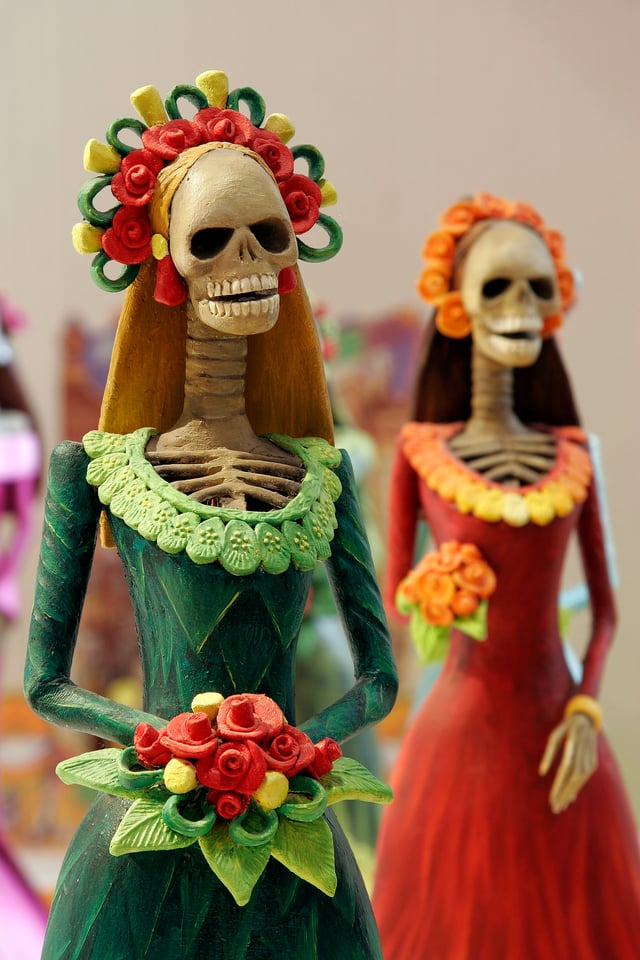
Modern representations of Catrina
In many American communities with Mexican residents, Day of the Dead celebrations are very similar to those held in Mexico.
In some of these communities, in states such as Texas, [47] New Mexico, [47] and Arizona, [47] the celebrations tend to be mostly traditional.
The All Souls Procession has been an annual Tucson, Arizona event since 1990.
The event combines elements of traditional Day of the Dead celebrations with those of pagan harvest festivals.
People wearing masks carry signs honoring the dead and an urn in which people can place slips of paper with prayers on them to be burned.
[47] Likewise, Old Town San Diego, California annually hosts a traditional two-day celebration culminating in a candlelight procession to the historic El Campo Santo Cemetery.
In Missoula, Montana, celebrants wearing skeleton costumes and walking on stilts, riding novelty bicycles, and traveling on skis parade through town.
The festival also is held annually at historic Forest Hills Cemetery in Boston's Jamaica Plain neighborhood.
Sponsored by Forest Hills Educational Trust and the folkloric performance group La Piñata, the Day of the Dead festivities celebrate the cycle of life and death.
People bring offerings of flowers, photos, mementos, and food for their departed loved ones, which they place at an elaborately and colorfully decorated altar.
A program of traditional music and dance also accompanies the community event.
The Smithsonian Institution, in collaboration with the University of Texas at El Paso and Second Life, have created a Smithsonian Latino Virtual Museum and accompanying multimedia e-book:* Día de los Muertos: Day of the Dead*.
The project's website contains some of the text and images which explain the origins of some of the customary core practices related to the Day of the Dead, such as the background beliefs and the* offrenda* (the special altar commemorating one's deceased loved one).
[47] The Made For iTunes multimedia e-book version provides additional content, such as further details; additional photo galleries; pop-up profiles of influential Latino artists and cultural figures over the decades; and video clips [48] of interviews with artists who make Dia de Muertos-themed artwork, explanations and performances of Aztec and other traditional dances, an animation short that explains the customs to children, virtual poetry readings in English and Spanish.
California
.jpg)
Anánima for the dead
Santa Ana, California s said to hold the "largest event in Southern California" honoring Día de Muertos, called the annual Noche de Altares, which began in 2002.
[48] The celebration of the Day of the Dead in Santa Ana has grown to two large events with the creation of an event held at the Santa Ana Regional Transportation Center for the first time on November 1, 2015.
In other communities, interactions between Mexican traditions and American culture are resulting in celebrations in which Mexican traditions are being extended to make artistic or sometimes political statements.
For example, in Los Angeles, California, the Self Help Graphics & Art Mexican-American cultural center presents an annual Day of the Dead celebration that includes both traditional and political elements, such as altars to honor the victims of the Iraq War, highlighting the high casualty rate among Latino soldiers.
An updated, intercultural version of the Day of the Dead is also evolving at Hollywood Forever Cemetery.
[48] There, in a mixture of Native Californian art, Mexican traditions and Hollywood hip, conventional altars are set up side-by-side with altars to Jayne Mansfield and Johnny Ramone.
Colorful native dancers and music intermix with performance artists, while sly pranksters play on traditional themes.
Similar traditional and intercultural updating of Mexican celebrations are held in San Francisco.
For example, the Galería de la Raza, SomArts Cultural Center, Mission Cultural Center, de Young Museum and altars at Garfield Square by the Marigold Project.
[48] Oakland is home toCorazon Del Pueblo in the Fruitvale district.* Corazon Del Pueblo*has a shop offering handcrafted Mexican gifts and a museum devoted to Day of the Dead artifacts.
Also, the Fruitvale district in Oakland serves as the hub of the* Dia de Muertos* annual festival which occurs the last weekend of October.
Here, a mix of several Mexican traditions come together with traditional Aztec dancers, regional Mexican music, and other Mexican artisans to celebrate the day.
South America
Bolivia
Dia de los ñatitas ("Day of the Skulls") is a festival celebrated in La Paz, Bolivia, on May 5.
In pre-Columbian times indigenous Andeans had a tradition of sharing a day with the bones of their ancestors on the third year after burial.
Today families keep only the skulls for such rituals.
Traditionally, the skulls of family members are kept at home to watch over the family and protect them during the year.
On November 9, the family crowns the skulls with fresh flowers, sometimes also dressing them in various garments, and making offerings of cigarettes, coca leaves, alcohol, and various other items in thanks for the year's protection.
The skulls are also sometimes taken to the central cemetery in La Paz for a special Mass and blessing.
Brazil
The Brazilian public holiday ofFinados (Day of the Dead) is celebrated on November 2.
Similar to other Day of the Dead celebrations, people go to cemeteries and churches with flowers and candles and offer prayers.
The celebration is intended as a positive honoring of the dead.
Memorializing the dead draws from indigenous, African and European Catholic origins.
Ecuador
In Ecuador the Day of the Dead is observed to some extent by all parts of society, though it is especially important to the indigenous Kichwa peoples, who make up an estimated quarter of the population.* Indigenacolada moradaguagua de pan ng traditional to the city of Loja.
The bread, which is wheat flour-based today, but was made with masa in the pre-Columbian era, can be made savory with cheese inside or sweet with a filling of guava paste.
These traditions have permeated mainstream society, as well, where food establishments add bothcolada morada andgaugua de pan to their menus for the season.
Many non-indigenous Ecuadorians visit the graves of the deceased, cleaning and bringing flowers, or preparing the traditional foods, too.
Peru
Usually people visit the cemetery and bring flowers to decorate the graves of dead relatives.
Sometimes people play music at the cemetery.
Similar traditions
Many other cultures around the world have similar traditions of a day set aside to visit the graves of deceased family members.
Often included in these traditions are celebrations, food, and beverages, in addition to prayers and remembrances of the departed.
The Qingming Festival ( simplified Chinese: 清明节 ; traditional Chinese: 清明節 ; pinyin:* qīng míng jié* ) is a traditional Chinese festival usually occurring around April 5 of the Gregorian calendar.
Along with Double Ninth Festival on the 9th day of the 9th month in the Chinese calendar, it is a time to tend to the graves of departed ones.
In addition, in the Chinese tradition, the seventh month in the Chinese calendar is called the Ghost Month (鬼月), in which ghosts and spirits come out from the underworld to visit earth.
The Bon Festival (O-bon ( お盆 ) , or only Bon ( 盆 ) ), is a Japanese Buddhist holiday held in August to honor the spirits of departed ancestors.
It is derived in part from the Chinese observance of the Ghost Month, and was affixed to the solar calendar along with other traditional Japanese holidays.
In Korea,Chuseoken|Chuseok|Chuseok]] (추석, 秋夕; also called*r traditional holiday.
People go where the spirits of their ancestors are enshrined, and perform ancestral worship rituals early in the morning.
They visit the tombs of immediate ancestors to trim plants, clean the area around the tomb, and offer food, drink, and crops to their ancestors.
During the Nepalese holiday ofGai Jatraen|Gai_Jatra|Gai Jatra]] ("Cow Pilgrimage"), every family who has lost a member during the previous year creates a*hes, cloth, and paper decorations, in which are placed portraits of the deceased.
As a cow traditionally leads the spirits of the dead into the afterlife, an actual or symbolic cow is used depending on local custom.
The festival is also a time to dress up in a costume reminiscent of the western Halloween, with popular subjects including political commentary and satire.
In popular culture
The 2014The Book of Life film follows a bullfighter who, on the Day of the Dead, embarks on an afterlife adventure.
In the 2015 James Bond film,Spectre, the opening sequence featured a Day of the Dead parade in Mexico City.
At the time, no such parade took place in Mexico City; one year later, due to the interest in the film and the government desire to promote the pre-Hispanic Mexican culture, the federal and local authorities decided to organize an actual "Día de Muertos" parade through Paseo de la Reforma and Centro Historico on October 29, 2016, which was attended by 250,000 people.
The 2016Elena of Avalor season one episode "A Night to Remember" focused on Dias de los Muertos.
The 2017 filmCoco features the Dias de los Muertos holiday in its plot.
See also
Literary Calaverita
Danse Macabre
Samhain
Skull art
Thursday of the Dead
Veneration of the dead
Walpurgis Night
